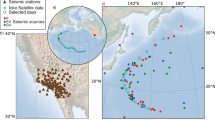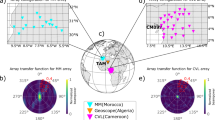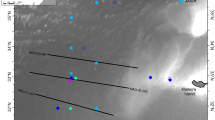Abstract
THE experiments of Hill and Swallow1 in August 1949 showed that the method of seismic refraction shooting at sea, which had been developed at Cambridge, was suitable for deep ocean work. Effort was therefore applied to reap some of the harvest of results that await this new technique of studying the structure of the sea bed. Through the kind co-operation of the Hydrographer of the Navy, further experiments are being undertaken as part of the oceanographical work done by H.M.S. Challenger during her present survey cruise.
This is a preview of subscription content, access via your institution
Access options
Subscribe to this journal
Receive 51 print issues and online access
$199.00 per year
only $3.90 per issue
Buy this article
- Purchase on Springer Link
- Instant access to full article PDF
Prices may be subject to local taxes which are calculated during checkout
Similar content being viewed by others
References
Hill, M. N., and Swallow, J. C., Nature, 165, 193 (1950).
Author information
Authors and Affiliations
Rights and permissions
About this article
Cite this article
GASKELL, T., SWALLOW, J. Seismic Refraction Experiments in the North Atlantic. Nature 167, 723–724 (1951). https://doi.org/10.1038/167723a0
Issue Date:
DOI: https://doi.org/10.1038/167723a0
This article is cited by
Comments
By submitting a comment you agree to abide by our Terms and Community Guidelines. If you find something abusive or that does not comply with our terms or guidelines please flag it as inappropriate.



